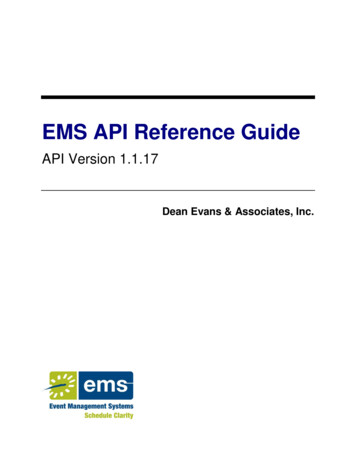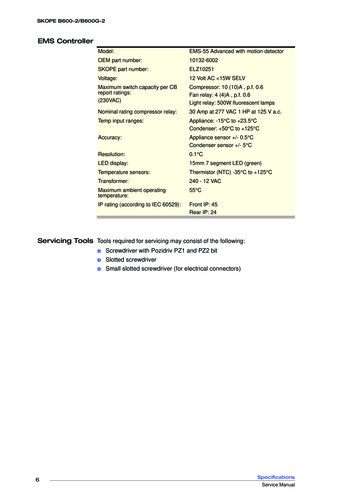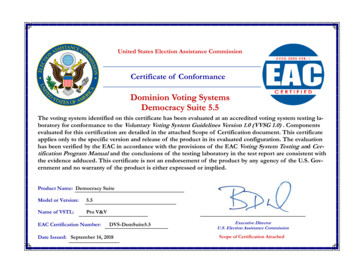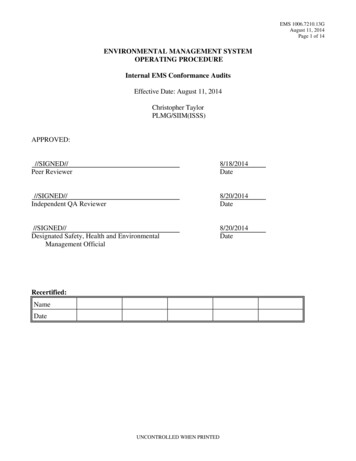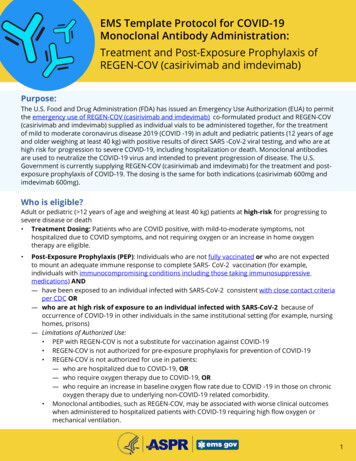
Transcription
EMS Template Protocol for COVID-19Monoclonal Antibody Administration:Treatment and Post-Exposure Prophylaxis ofREGEN-COV (casirivimab and imdevimab)Purpose:The U.S. Food and Drug Administration (FDA) has issued an Emergency Use Authorization (EUA) to permitthe emergency use of REGEN-COV (casirivimab and imdevimab) co-formulated product and REGEN-COV(casirivimab and imdevimab) supplied as individual vials to be administered together, for the treatmentof mild to moderate coronavirus disease 2019 (COVID -19) in adult and pediatric patients (12 years of ageand older weighing at least 40 kg) with positive results of direct SARS -CoV-2 viral testing, and who are athigh risk for progression to severe COVID-19, including hospitalization or death. Monoclonal antibodiesare used to neutralize the COVID-19 virus and intended to prevent progression of disease. The U.S.Government is currently supplying REGEN-COV (casirivimab and imdevimab) for the treatment and postexposure prophylaxis of COVID-19. The dosing is the same for both indications (casirivimab 600mg andimdevimab 600mg).Who is eligible?Adult or pediatric ( 12 years of age and weighing at least 40 kg) patients at high-risk for progressing tosevere disease or death Treatment Dosing: Patients who are COVID positive, with mild-to-moderate symptoms, nothospitalized due to COVID symptoms, and not requiring oxygen or an increase in home oxygentherapy are eligible. Post-Exposure Prophylaxis (PEP): Individuals who are not fully vaccinated or who are not expectedto mount an adequate immune response to complete SARS- CoV-2 vaccination (for example,individuals with immunocompromising conditions including those taking immunosuppressivemedications) AND— have been exposed to an individual infected with SARS-CoV-2 consistent with close contact criteriaper CDC OR— who are at high risk of exposure to an individual infected with SARS-CoV-2 because ofoccurrence of COVID-19 in other individuals in the same institutional setting (for example, nursinghomes, prisons)— Limitations of Authorized Use: PEP with REGEN-COV is not a substitute for vaccination against COVID-19 REGEN-COV is not authorized for pre-exposure prophylaxis for prevention of COVID-19 REGEN-COV is not authorized for use in patients:— who are hospitalized due to COVID-19, OR— who require oxygen therapy due to COVID-19, OR— who require an increase in baseline oxygen flow rate due to COVID -19 in those on chronicoxygen therapy due to underlying non-COVID-19 related comorbidity. Monoclonal antibodies, such as REGEN-COV, may be associated with worse clinical outcomeswhen administered to hospitalized patients with COVID-19 requiring high flow oxygen ormechanical ventilation.1
EMS Template Protocol for COVID-19Monoclonal Antibody Administration:Treatment and Post-Exposure Prophylaxis ofREGEN-COV (casirivimab and imdevimab)Risk factors for development of severe COVID include, but are notlimited to: (for both treatment and PEP indications) Older age (for example 65 years of age) Obesity or being overweight (for example, adults with BMI 25, or if age 12-17, have BMI 85th percentile for their age and gender based on CDC growth charts) Pregnancy Chronic kidney disease Diabetes Immunosuppressive disease or immunosuppressive treatment Cardiovascular disease (including congenital heart disease) or hypertension Chronic lung diseases (for example, chronic obstructive pulmonary disease, asthma[moderate-to-severe], interstitial lung disease, cystic ibrosis, and pulmonary hypertension) Sickle cell disease Neurodevelopmental disorders (for example, cerebral palsy) or other conditions that confermedical complexity (for example, genetic or metabolic syndromes and severe congenitalabnormalities) Having a medical-related technological dependence (for example, tracheostomy,gastrostomy, or positive pressure ventilation (not related to COVID-19)Other medical conditions or factors (for example, race or ethnicity) may also place individualpatients at high risk for progression to severe COVID-19 and authorization of mAb therapyis not limited to the medical conditions or factors listed above. (For additional informationon medical conditions and factors associated with increased risk for progression to severeCOVID-19, visit the CDC website).What are the routes of administration for REGEN-COV?1. Intravenous (IV): casirivimab 600mg and imdevimab 600mg by infusion2. Subcutaneous: four injections given in the same visit totaling casirivimab 600mg and imdevimab600mg.3. For treatment of symptomatic COVID-19, the intravenous route is preferred under the EUA, but ifthere would be a delay in providing IV administration, subcutaneous administration is acceptable.4. For PEP, subcutaneous and intravenous administration are viewed clinically equivalent.2
EMS Template Protocol for COVID-19Monoclonal Antibody Administration:Treatment and Post-Exposure Prophylaxis ofREGEN-COV (casirivimab and imdevimab)Management of adverse reaction to intravenous infusion or subcutaneousadministration: Implement the following actions in case of hypersensitivity or allergic reactions:NOTE: these actions should be based on local EMS protocol as approved by the EMS Medical DirectorShortness of BreathTightness in the ChestGlossal EdemaAngioedemaPeriorbital or Facial cardiaLightheadedness/DizzinessDiarrhea1. Stop infusion or do not administer additional subcutaneous injections2. Stay with patient3. Activate transporting EMS agency4. Maintain patent airway and administer oxygen as needed per protocol5. Establish IV access and initiate cardiac monitoring6. Be prepared to administer emergency medications per protocol Epinephrine (1:1,000) Intramuscular Injection –0.3mg IM or epi auto-injector Benadryl IV Injection Hydrocortisone, Methylprednisolone orDexamethasone IV Injection Albuterol 2.5mg nebulized or via MDI ifwheezing/dyspnea7. Obtain 12 Lead ECG if epinephrine administered8. Initiate transport per local EMS protocol9. Consult online medical control as appropriate3
EMS Template Protocol for COVID-19Monoclonal Antibody Administration:Treatment and Post-Exposure Prophylaxis ofREGEN-COV (casirivimab and imdevimab)Basic Equipment:Equipment requirements may vary by medical direction. Follow your local requirements whendetermining the equipment needed for your treatment setting. The following equipment shouldbe considered to ensure the most optimal care environment for patients receiving REGEN-COV.This list is not intended to substitute for your independent medical judgment.Personal Protective EquipmentInjection Supplies Gloves/gowns Eye and face protection (e.g., goggles,safety glasses, face shields)3-mL or 5-mL polypropylene Luer locksyringe with Luer connection 21 gauge 1.5-inch transfer needles 25-gauge or 27-gauge needle forsubcutaneous injection NIOSH-certified facepiece respirators orbetterInfusion SuppliesGeneral SuppliesAdministration set Bag-valve-mask Vital signs equipment Adverse reaction management kit Sterile in-line 0.2/0.22 micron filter (maybe integrated into administration set orseparate add-on device) IV 0.9% normal saline and catheters Infusion pumps (if available) 3-mL saline syringes Appropriately sized syringes Alcohol wipes 2x2 gauze pads Adhesive bandages — IV diphenhydramine,— IV corticosteroid (e.g.,methylprednisolone 125 mg),— epinephrine (auto-injector preferred),— oxygen and delivery devices (nasalcannula and non-rebreather mask) Locking refrigerator with temperaturemonitoring capabilityOcclusive dressing Biohazard disposal bag Absorbent under pads (blue pads) Disposable disinfection wipes Extension set tubing Thermometer probe covers (if required) 18-gauge stainless steel needles 70% alcohol wipes Sharps container Paper towels Tape Trash bins and liners4
EMS Template Protocol for COVID-19Monoclonal Antibody Administration:Treatment and Post-Exposure Prophylaxis ofREGEN-COV (casirivimab and imdevimab)Storage and Handling:Casirivimab and imdevimab are preservative-free. Discard any unused portion after use. Store unopenedvials in a refrigerator at 2ºC to 8 C (36 F to 46 F) in the original carton to protect from light.DO NOT FREEZE—DO NOT SHAKE—DO NOT EXPOSE TO DIRECT LIGHT OR HEATIf given by intravenous infusion, solution in vial requires dilution prior to administration. The preparedinfusion solution is intended to be used immediately. If immediate administration is not possible, storediluted casirivimab and imdevimab solution in the refrigerator at 2ºC to 8ºC (36ºF to 46ºF) for no morethan 36 hours or at room temperature up to 25ºC (77ºF) for no more than 4 hours. If refrigerated, allowthe infusion to equilibrate to room temperature for approximately 30 minutes prior to administration.If given by subcutaneous injection, the prepared syringes should be used immediately. If immediateadministration is not possible, store the prepared casirivimab and imdevimab syringes in the refrigeratorat 2ºC to 8ºC (36ºF to 46ºF) for no more than 4 hours or at room temperature up to 25ºC (77ºF) forno more than 4 hours. If refrigerated, allow the syringes to equilibrate to room temperature forapproximately 20 minutes prior to administration.Medication Administration:Preparation for Intravenous Infusion Prepared infusion solution should not be administered with any other medication. Casirivimab and imdevimab will be prepared by placing casirivimab 600mg and imdevimab 600mg ina 100 mL NS bag. The total volume of 110 mL is to be infused IVPB in a NS KVO primary line over21 minutes (310 mL/hr). Prime the medication IV bag with a polyvinyl chloride (PVC), polyethylene (PE)-lined PVC orpolyurethane (PU) infusion set containing a 0.20 or 0.22 micron filter (provided by pharmacy). Take vital signs (VS) before start of infusion. Monitor the patient for 2-3 minutes after the start of theinfusion for any signs of hypersensitivity or allergic reactions such as:Shortness of BreathTightness in the ChestGlossal EdemaAngioedemaPeriorbital or Facial cardiaLightheadedness/DizzinessDiarrheaFollow the usual documentation requirements relevant to medication administration, patientassessments, and vital signs monitoring, including any adverse reactions. After infusion is complete, flush the line to ensure complete medication administration per protocol. Take vital signs for 60 minutes after infusion or completion of all four subcutaneous injections.5
COVID-19 Monoclonal Antibody Administration:Subcutaneous Injection REGEN-COV(casirivimab and imdevimab)Preparation for Subcutaneous InjectionRemove the casirivimab and imdevimab vial(s) from refrigerated storage and allow to equilibrate to roomtemperature for approximately 20 minutes before preparation. Do not expose to direct heat. Do notshake the vial(s).Inspect casirivimab and imdevimab vial(s) visually for particulate matter and discoloration prior toadministration. Should either be observed, the vial must be discarded, and a new vial must be used. Thesolution for each vial should be clear to slightly opalescent, colorless to pale yellow.1. 600 mg of casirivimab and 600 mgof imdevimab should be preparedusing 4 syringes (see table below).Obtain four 3-mL or 5-mLpolypropylene Luer lock syringeswith Luer connection and four 21gauge, 1½-inch transfer needles.2. Withdraw 2.5 mL into eachsyringe (total of 4 syringes) (seetable below). Prepare all 4syringes at the same time. If individual vials ofcasirivimab and imdevimabare being used, considerlabeling syringes duringpreparation to ensure the twosyringes of casirivimab andtwo syringes of imdevimabare identifiable3. Replace the 21-gauge transferneedle with a 25-gauge or 27gauge needle for subcutaneousinjection.4. This product is preservative-freeand therefore, the preparedsyringes should be administeredimmediately. If immediateadministration is not possible, storethe prepared casirivimab andimdevimab syringes in therefrigerator between 2 ºC to 8 ºC(36 ºF to 46 ºF) for no more thanfour hours or at room temperatureup to 25 ºC (77 ºF) for no morethan four total hours. If refrigerated,allow the syringes to equilibrate toroom temperature forapproximately 20 minutes prior toadministration.
COVID-19 Monoclonal Antibody Administration:Subcutaneous Injection REGEN-COV(casirivimab and imdevimab)Administration for Subcutaneous Injection For the administration of 600 mg of casirivimab and 600 mg of imdevimab, gather four syringes(see table on prior page) and prepare for subcutaneous injections.Administer the subcutaneous injections consecutively, each at a different injection site, into thethigh, back of upper arm, or abdomen, except for two inches (5 cm) around the navel. Thewaistline should be avoided.When administering the subcutaneous injections, it is recommended that providers usedifferent quadrants of the abdomen or upper thighs or back of the upper arms to space aparteach 2.5 mL subcutaneous injection of casirivimab and imdevimab. DO NOT inject into skinthat is tender, damaged, bruised, or scarred.Clinically monitor patients after injections and observe patients for at least one hour.Subcutaneous Injection SitesAdditional Resources:COVID-19 Monoclonal Antibody Therapeutics: www.phe.gov/mAbREGEN-COV Dosing & Administration: trationAugust 25, 2021
occurrence of COVID-19 in other individuals in the same institutional setting (for example, nursing homes, prisons) — Limitations of Authorized Use: PEP with REGEN-COV is not a substitute for vaccination against COVID-19 REGEN-COV is not authorized for pre-exposure prophylaxis for prevention of COVID-19
